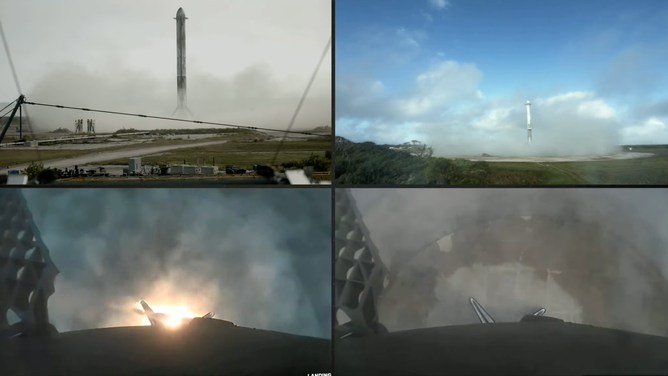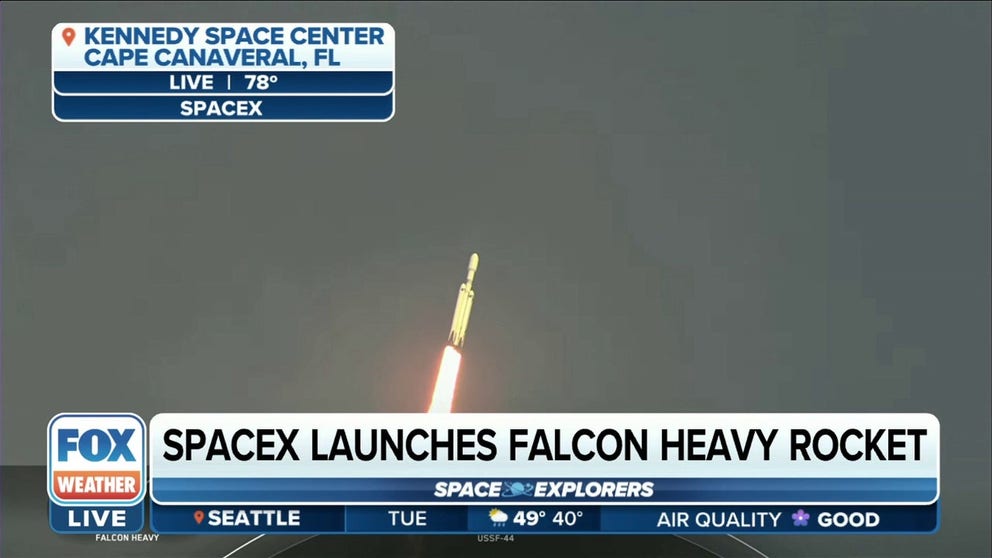First SpaceX Falcon Heavy launches from Florida in three years, creating double sonic booms
SpaceX launched the US Space Force spacecraft known as USSF-44 from Kennedy Space Center on Tuesday. People in Central Florida could hear sonic booms for the Falcon Heavy double booster landing.
SpaceX launches Falcon Heavy rocket
Tuesday's launch marked the first national security mission for the Falcon Heavy rocket.
KENNEDY SPACE CENTER, Fla. – The first SpaceX Falcon Heavy rocket to launch in three years soared above a thick blanket of fog Tuesday morning sending a top-secret U.S. national security mission to space.
SpaceX launched the world's most powerful rocket at 9:41 a.m. using more than 5 million pounds of thrust to rise above the dense fog and into the blue sky.
Inside the Falcon Heavy fairings, or nose cone, was the U.S. Space Force spacecraft known as USSF-44.
Ahead of the launch, forecasters with the Space Force 45th Weather Squadron predicted a nearly perfect morning for liftoff with a 90% chance of favorable liftoff conditions.
Dense fog surrounded the Kennedy Space Center launchpad 39A and the rocket Tuesday morning. Still, fog is not a launch weather constraint and the countdown continued without issue.
If you missed it, you can re-watch the launch and double booster landing at the top of this story.
Sonic boom alert

Two SpaceX Falcon Heavy side boosters land at Cape Canaveral Landing Zone 1 after launching a U.S. Space Force mission from Kennedy Space Center, Florida on Nov. 1, 2022. (Image: SpaceX)
Officials with the Space Force's Space Launch Delta 45, which oversees the Eastern Range, warned people in the Central Florida region they might hear the rumbling sonic booms on Tuesday morning after the rocket's boosters land at Cape Canaveral.
As the boosters came back down, they break the sound barrier, sending shock waves – or sonic booms – that can be heard from Kennedy Space Center as far inland as Orlando.
SpaceX successfully landed both side boosters at Cape Canaveral Landing Zone 1 generating a double sonic boom.
The boosters returned to land about 8 minutes after launch. However, the rumble of the landing took even longer to reach areas farther from the landing site.
The landings marked the 150th and 151st rocket boosters SpaceX has successfully recovered post liftoff.
What is Falcon Heavy launching?
The U.S. Space Force contracted SpaceX to launch the USSF-44 mission. It marks the first national security mission for the Falcon Heavy.
According to the Space Force, the spacecraft has multiple payloads designed to test space technology for future programs.
"The Falcon Heavy is an important element of our overall lift capability, and we're very excited to be ready for launch," Program Executive Officer for Assured Access to Space Brig. Gen. Stephen Purdy, said ahead of launch. "Every national security launch brings important capabilities to the nation, and investments in space capabilities increase the effectiveness of operations in every other domain – the U.S. military is better connected, more informed, faster and precise because of space."
Falcon Heavy 3-year hiatus
5 things to know about the SpaceX Falcon Heavy rocket
As the world's most powerful rocket in operation, the SpaceX Falcon Heavy has 27 merlin engines and three rocket boosters.
The triple-rocket-booster Falcon Heavy hasn't launched from Florida in three years, unlike SpaceX's Falcon 9 rocket, launching weekly or sometimes more.
The Falcon Heavy is currently the most powerful rocket in the world and can launch heavier payloads than SpaceX's workhorse rocket, the Falcon 9. A Falcon Heavy launch is a unique experience to see in person.
Falcon Heavy has 27 Merlin engines and three first-stage boosters compared to the Falcon 9, with one first-stage booster and nine Merlin engines. At liftoff, the Falcon Heavy produces more than 5 million pounds of thrust to get off the planet.
SpaceX lands its rocket boosters on land and at sea to reuse the hardware, driving down the cost of launches by millions of dollars.
With three boosters, the Falcon Heavy's first stages perform a choreographed aerial ballet in the sky to return to Earth. One booster can land at sea on a drone ship, and two boosters head back to Cape Canaveral to land at Landing Zone 1 in near-perfect unison.
For the USSF-44 mission, only the two side boosters returned for landing.

